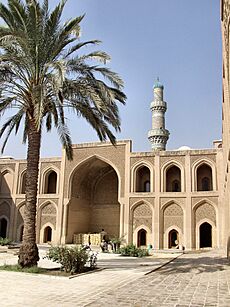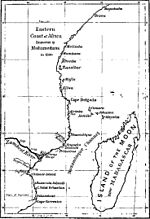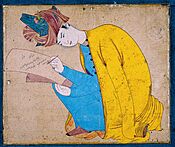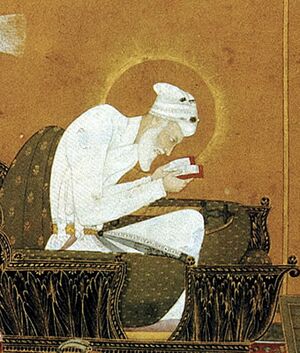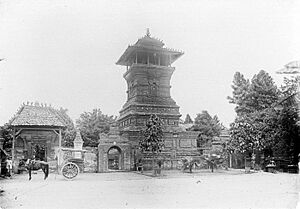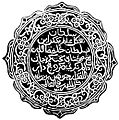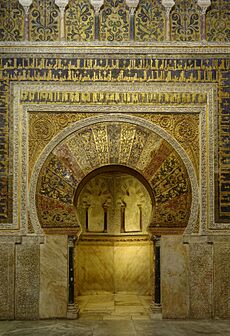Spread of Islam facts for kids
The spread of Islam has happened over almost 1,400 years. After the death of Muhammad in 632 CE, early Muslim armies expanded quickly. This led to the creation of large caliphates, which were like empires. Over time, more and more people chose to become Muslim.
Most of this big expansion happened during the time of the rāshidūn caliphs (632 to 661 CE). These were the first four leaders after Muhammad. These early empires, along with Muslim trade, the Islamic Golden Age, and later gunpowder empires, helped Islam spread. It went from Mecca towards the Indian Ocean, Atlantic Ocean, and Pacific Ocean. This created the Muslim world.
Trade was very important in spreading Islam in some places, like Indonesia. In the early years, people in the Middle East usually converted one by one. But outside Muslim lands, leaders often wanted many people to convert at once. There were some exceptions, like the Samaritans who were forced to convert.
Powerful Muslim dynasties and empires followed, like the Umayyads, Abbasids, and Ottoman Empire. These empires were some of the biggest and strongest in the world. People in the Islamic world created amazing centers of learning and science. Travelers, scientists, and thinkers all helped create the Islamic Golden Age.
By 2016, there were 1.7 billion Muslims. About one in four people in the world is Muslim, making Islam the second-largest religion. Islam is also the world's fastest-growing major religion.
How Islam Spread
The term "spread of Islam" describes how the religion grew. Other words like "Islamization" are also used. These terms mean a society changes to become mostly Muslim. This happened over many centuries as Islam spread outside the Arabian Peninsula.
This process happened in places like the Middle East, Iran, North Africa, West Africa, Central Asia, and South Asia. It also spread to Southeast Asia (like Malaysia and Indonesia) and parts of Europe (like the Balkans and Spain).
Early History of Islam's Growth
The history of Islam's spread is complex. It involved mixing Islamic ways with local customs over many centuries. Some experts say that Islam was not always spread by force.
Rashidun and Umayyad Caliphs (610–750 CE)
Within a century of Islam starting in the Arabian Peninsula, a huge empire was formed. For the people living in these new lands, not much changed at first. The main goal of the conquests was often practical, like finding fertile land and water. Real conversion to Islam happened more slowly over the next centuries.
People converted for different reasons. For tribal groups who believed in many gods, Islam offered a bigger framework for their lives. It brought a more stable government and a clear moral vision. For groups who already believed in one God, like Christians and Jews, Islam replaced their old political identity.
At first, the Arab conquerors did not always want people to convert. New Muslims could reduce the special benefits and status of the Arabs. Mass conversions happened later, as the ideas of Islam and the Muslim community (called ummah) grew stronger.
The first Arab rulers built schools to teach Arabic and Islamic studies. They also started building many mosques, like the Umayyad Mosque in Damascus. By the end of the Umayyad period, less than 10% of people in places like Iran, Iraq, and Egypt were Muslim. Only the Arabian Peninsula had more Muslims.
Abbasid Caliphate (750–1258)
The Abbasids took over from the Umayyads. During their time, Islamic science, philosophy, theology, and law became more widespread. More people in the empire slowly converted to Islam.
Islam also spread beyond the empire's borders. Turkic tribes in Central Asia and people south of the Sahara in Africa converted. This happened through contact with Muslim traders and Sufi teachers. In Africa, Islam spread along trade routes across the Sahara, up the Nile Valley, and down East Africa.
By the end of the 10th century, many people had converted to Islam. Islam had become more clearly defined, with its own rituals and laws. Non-Muslims, like Christians and Jews, were called "People of the Book." They were generally not forced to convert, but they had some restrictions. They paid a special tax called jizya and could not marry Muslim women.
Historian Ira Lapidus noted that people converted for both worldly and spiritual reasons. Conversion to Islam did not always mean completely leaving an old life. Many converts kept strong ties to their old cultures. This is why Muslim societies today are so diverse.
During the Abbasid period, economic problems and pressure from Muslim attackers led to many Samaritans converting to Islam. Along with the religion, the Arabic language, Arabic numbers, and Arab customs spread throughout the empire. By the end of the 10th century, a clear Islamic world had formed.
Seljuks and Ottomans (950–1450)
Islam continued to spread with the conquests of Turkic groups in Asia Minor (modern Turkey), the Balkans, and the Indian subcontinent. In some areas, like Sicily and Spain, Muslim populations were later expelled or forced to become Christian.
The Mongol invasion in 1258 was a big event. After a time of persecution, many Mongol conquerors themselves converted to Islam.
Ottoman Empire (1299–1924)

The Ottoman Empire was a powerful Muslim empire that lasted for centuries. It controlled much of the Middle East and North Africa. The Ottomans expanded their lands, conquering territories from rivals like the Byzantine Empire and Catholic powers.
The Ottoman sultanate ended in 1922, and the caliphate ended in 1924.
Modern Spread of Islam
Islam has continued to spread through trade and migration, especially in Southeast Asia, America, and Europe. Today, "Islamization" can also mean individuals returning to Muslim values and strengthening their communities.
Many Muslim immigrants and their children in non-Muslim countries feel a "growing universalistic Islamic identity." This means they feel connected to a single Islam practiced similarly everywhere, beyond national customs. This doesn't always mean political groups, but often involves local activities like worship and charity.
Islam's Spread by Region
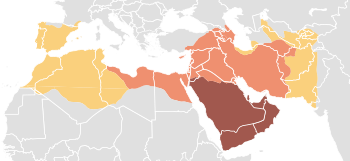
Greater Syria
Palestine
The Siege of Jerusalem (636–637) by Muslim forces began in November 636. The Christian leader, Sophronius, agreed to surrender Jerusalem to the Muslim leader, Umar. Umar traveled to Jerusalem to sign the agreement in 637.
This agreement, called Umar's Assurance, allowed Christians to practice their religion freely. In return, they paid the jizya tax. Under Muslim rule, Jews and Christians in Jerusalem were generally tolerated. Umar even refused to pray inside a church, so Muslims would not take it over later.
Early Muslim rulers in Damascus (661-750) were often tolerant of Christians. Many Christians held important jobs in their courts. Later, under the Fatimid Caliphate (whose capital was Cairo), Jerusalem became a battleground. Tolerance for other religions decreased. In 1009, the Holy Sepulchre church was destroyed, which helped lead to the First Crusade.
Africa
North Africa
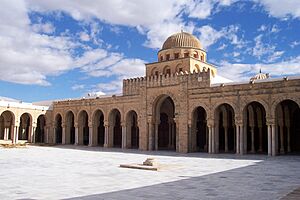
In Egypt, conversion to Islam was slower than in other areas. Muslims likely became the majority around the 14th century. The victorious Muslims allowed Christians in Alexandria religious freedom.
The Arabs ended Byzantine rule in North Africa, invading Tunisia in 647 and Morocco in 682. In 670, the Arab general Uqba Ibn Nafi founded the city of Kairouan and its Great Mosque. This mosque is considered the ancestor of all mosques in the western Islamic world.
The Arabs converted the Berbers and used their help in further conquests, like in Spain. By the 11th century, Islam had spread deep into the Sahara and Sahel.
Some historians used to think that Catholicism ended in Africa after the Muslim conquest. However, new studies show that Christian communities continued to exist for centuries. There is evidence of Christian pilgrimages and contact with Christians in Arab Spain.
Horn of Africa
Early Muslims fled to the port city of Zeila in modern-day Somaliland to escape persecution. Some settled there and helped spread Islam. When Arab traders in Arabia adopted Islam, the major trade routes came under Muslim control. Through trade, Islam spread among the Somali people in coastal cities.
East Africa
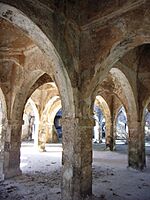
On the east coast of Africa, Arab sailors had traded for many years. They founded permanent settlements on islands like Zanzibar in the 9th and 10th centuries. From there, Arab trade routes into Africa helped Islam slowly spread.
By the 10th century, the Kilwa Sultanate was founded. It became the most powerful sultanate on the Swahili coast. The 13th-century Muslim traveler Ibn Battuta noted that the great mosque of Kilwa Kisiwani was made of coral stone.
In the 20th century, Islam continued to grow in Africa through births and conversions.
Western Africa
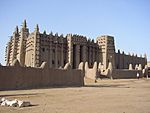
Islam began spreading in West Africa from the 7th to 9th centuries. It came peacefully through extensive trade networks. Sharing a common religion and the Arabic language helped traders trust each other more. In the 19th century, the Sokoto Caliphate in Northern Nigeria actively spread Islam.
Persia and the Caucasus
Islam entered Persia (modern Iran) after the Islamic conquest of Persia in the 7th century. It was once thought that the old Persian religion, Zoroastrianism, quickly disappeared. However, it was a slower process. Arab tribes also migrated into the region.
Conversion was fastest in cities where Arab armies were stationed. By the end of the Umayyad period, Muslims were still a minority in the region. By the 16th century, most people in Iran and Azerbaijan had adopted the Shia branch of Islam.
Muslim missionaries found it easy to explain Islam to Zoroastrians because the faiths had similarities. Sometimes, Muslim leaders encouraged conversion by offering money or allowing the Quran to be recited in Persian.
Central Asia
Many people in Afghanistan accepted Islam through Umayyad efforts. Later, starting in the 9th century, the Samanids helped spread Sunni Islam and Islamic-Persian culture into Central Asia. Many Turks converted to Islam during this time.
After the Samanids, the Ghaznavids and later the powerful Ghurids and Timurids further spread Islamic culture, reaching as far as Bengal.
Indian Subcontinent

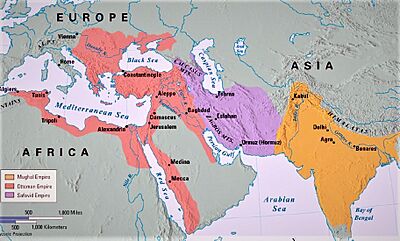
Islamic influence first reached the Indian subcontinent in the early 7th century through Arab traders. These traders visited the Malabar region even before Islam was established in Arabia. The first Indian mosque is believed to have been built in 629 CE in Kodungallur.
In Bengal, Arab merchants helped found the Port of Chittagong. Early Sufi missionaries settled there as early as the 8th century. Arab merchants and traders carried the new religion wherever they went. The later expansion of Muslim rule over the next thousand years established Islam in the region.
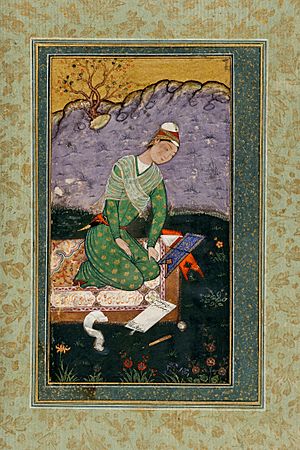
There is much discussion about how conversion to Islam happened in India. Some believe it was initially by force or pressure. Others see it as a long social process where people gradually joined the Muslim world. Some converted for practical reasons, like social status or tax relief. Many Muslims in India are also descendants of migrants from Persia or Arabia.
Muslim missionaries, sometimes disguised as traders, played a key role. For example, in the 9th century, Ismailis sent missionaries across Asia. They spoke to potential converts in their own language. Some even tried to make their religion acceptable to Hindus by linking their beliefs to Hindu gods.
The Mughal Empire, founded by Babur, conquered almost all of South Asia. While Emperor Akbar showed religious tolerance, Emperor Aurangzeb later fully established Islamic law and brought back the Jizya tax on non-Muslims. The Mughal Empire declined in the 18th century, leading to smaller powers taking control.
Southeast Asia
Even before Islam was fully established in Indonesia, Muslim sailors and traders visited its shores. Many came from the Abbasid Caliphate. They noted animals like orang-utans and valuable spices.
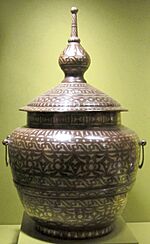
Islam came to Southeast Asia first through Muslim traders. Then, Sufi teachers helped spread it further. Finally, it was strengthened as rulers and their communities converted. The first Muslim communities appeared in Northern Sumatra. The Malacca's became a stronghold of Islam.
There is no exact date for Islam's arrival. The first Muslim gravestone is from 1082. When Marco Polo visited in 1292, he noted that the port of Perlak was Muslim. Chinese sources also mention Muslim delegations. The spread of Islam generally followed trade routes.
In 1380, Sufi teachers brought Islam to Mindanao. The Majapahit Empire in Java was a Hindu kingdom. As trade with the Muslim world grew, Islamic influence reached the court. By the time Raja Kertawijaya converted in 1475, the Sultanate was already becoming Muslim. In Vietnam, the Cham people converted through contact with traders.
Another reason for the change in ruling classes was that Muslim communities wanted to form family ties through marriage. By the 17th century, when European colonial powers arrived, most of the region up to New Guinea was Muslim.
Flags of the Sultanates in the East Indies
Inner Asia and Eastern Europe
In the mid-7th century, Islam reached parts of what would later become European Russia. Later, in the 11th century, a Muslim prisoner taught and converted people among the Pechenegs.
Little is known about when Islam spread in Inner Asia and among the Turkic peoples. Around the 7th and 8th centuries, Turkic states fought against the caliphate to stop Arab and Islamic influence. From the 9th century, Turks began to convert. The Bulgars of the Volga adopted Islam by the 10th century.
The Qarakhanid dynasty in Central Asia was established by Karluks who became Muslim in the mid-10th century. The modern history of Islam in the region dates to the Golden Horde, founded by Jochi, son of Genghis Khan. Berke Khan was the first Mongol ruler to officially adopt Islam. Later, Uzbeg Khan (1282–1341) converted, and many Mongols followed.
Some Mongolian tribes also became Muslim. After the Mongol invasion of Central Asia and the Battle of Baghdad (1258), Mongol rule spread across Muslim lands in Asia. The Mongols initially persecuted Islam, but in 1295, the new Khan, Ghazan, converted to Islam. This led to a new blend of Mongol and Islamic cultures, shaping the spread of Islam in Central Asia and India.
In the 1330s, the Mongol ruler of the Chagatai Khanate converted to Islam. Over the next three centuries, Buddhist, Shamanistic, and Christian Turkic and Mongol nomads in the Kazakh Steppe and Xinjiang also converted.
Europe
Tariq ibn Ziyad was a Muslim general who led the Islamic conquest of Visigothic Hispania (Spain and Portugal) from 711-718 A.D. The name "Gibraltar" comes from the Arabic name Jabal Tāriq, meaning "mountain of Tariq."
There are also accounts of trade between Muslims and the Rus (Vikings) in European Russia. Some Rus reportedly converted to Islam.
Hispania / Al-Andalus
The history of Arab and Islamic rule in Spain is well-studied. An Arab-led army invaded in 711 and conquered southern and central Spain by 720. They briefly pushed into southern France but were pushed back by Charles Martel. Christian armies then began to push south.
A major event was when an Umayyad Prince escaped to Cordoba in Spain in 750 and created a new Islamic state. This started a unique Spanish Muslim society where Christians and Jews lived alongside a growing number of Muslims. Rulers generally allowed Christians and Jews to practice their religions, though non-Muslims faced some political and tax differences.
Over time, the Muslim population grew through conversions and assimilation. The Islamic state in Cordoba eventually broke into smaller kingdoms. The Christian kingdoms grew stronger. The last Muslim kingdom of Granada was taken in 1492 by Queen Isabelle and Ferdinand. In 1499, remaining Muslims were ordered to convert or leave. Many poor Muslims, called Moriscos, converted to Christianity but secretly practiced Islam.
Balkans
In the Balkans, the history of conversion to Islam is a sensitive political topic. It is linked to how national identities formed. Some believe all Islamization was forced by the Ottoman government. However, Islamization in each Balkan country happened over many centuries and depended on local conditions. Ottoman conquests were mainly military and economic, not primarily religious.
The Ottoman Empire allowed different religious groups, called millets, to have their own laws and leaders. Because of this, large parts of the Balkans remained Christian under Ottoman rule. Eastern Orthodox Churches even had a higher position. However, Roman Catholic areas like Bosnia, Kosovo, and northern Albania saw more conversions to Islam.
When the Ottomans lost Hungary and Croatia in 1699, many Muslims chose to leave. Later, new ideas of nationalism led Christian groups to see themselves as oppressed. Many Muslims in the Balkans chose to leave or were forced out. For example, the number of mosques in Belgrade decreased from over 70 in 1750 to only three in 1850.
Immigration
Since the 1960s, many Muslims have moved to Western Europe as immigrants or refugees. This has steadily increased the Muslim population in Europe. A 2011 study predicted that the proportion of Muslims in Europe would increase from 6% in 2010 to 8% in 2030.
See also
- Al-Hallaj
- Sinbuya Asvari
- Muslim population growth
- History of Islam
- Converts to Islam
- Conversion to Islam in U.S. prisons
- Religious conversion
- Islamism
- List of converts to Islam
- Muslim conquests
- Islamic missionary activity
- Muslim world
- Islam by country


